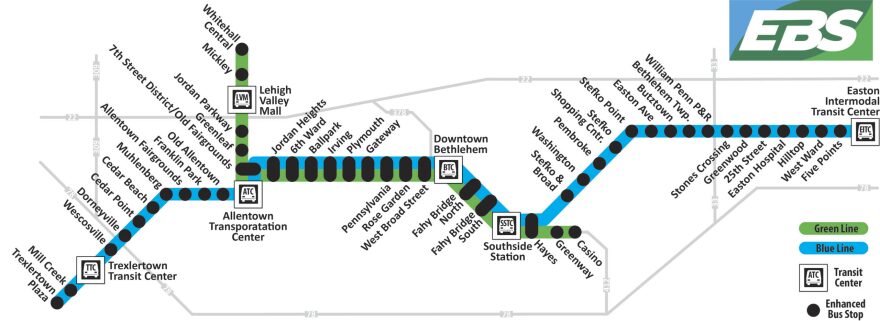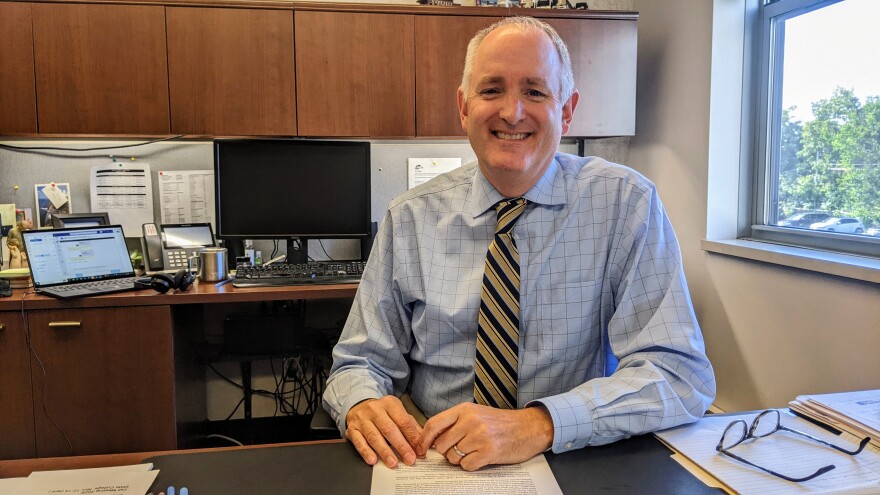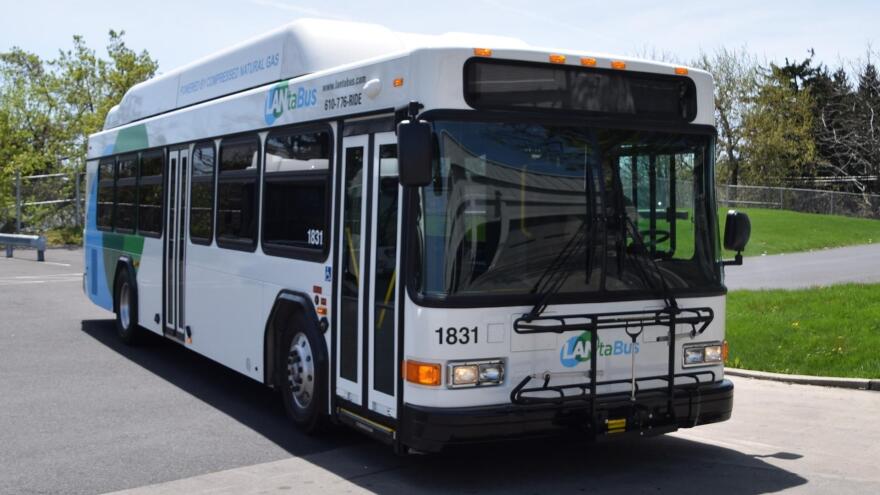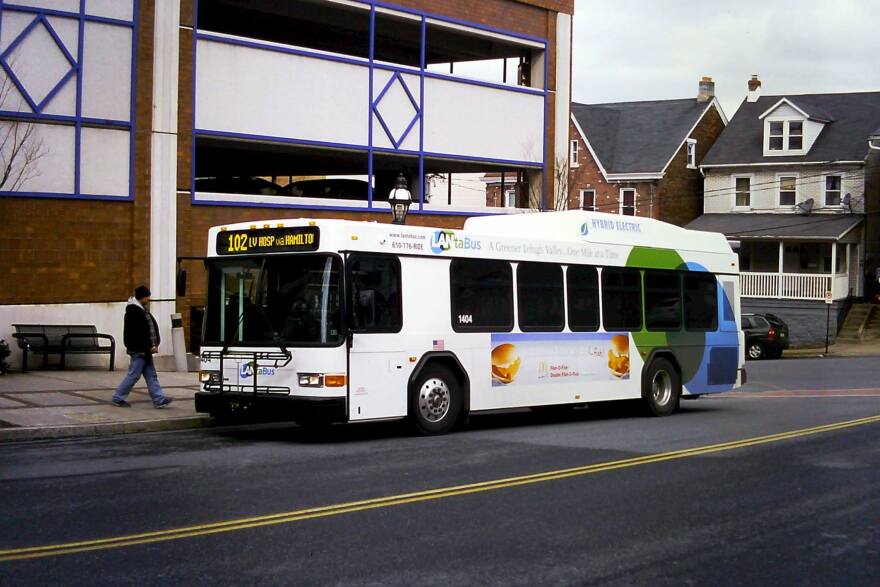- Despite challenges, LANTA leadership envisions a greater use of mixed-transit as a way to address the area's needs
- The most recent Lehigh Valley Planning Commission Long Range Transportation Plan sees more than $1.2 billion for LANTA over the next 25 years for fleet expansion and expenses
- LANTA recently launched an enhanced bus service throughout major corridors and seeks to manage the continued growth and traffic concerns of the area
ALLENTOWN, Pa. — As the Lehigh Valley's population is expected grow nearly 15% in the next 25 years, officials say getting those people where they need to go is going to require a stronger mixed-transit future.
Part of that will be Lehigh and Northampton Transportation Authority — but significantly different, and better, than the public bus system that has operated in the Lehigh Valley for more than 50 years.
"We've kind of outgrown the system we had," LANTA Executive Director Owen O'Neil said.
"We used to just be primarily bringing people to Mack Trucks and bringing people to Bethlehem Steel, and the region has outgrown that, so we really need a more robust transit system that responds to that.
"The Lehigh Valley isn't a small metro anymore."LANTA Executive Director Owen O'Neil
"The Lehigh Valley isn't a small metro anymore."
To make those needed changes, the study by the Lehigh Valley Transportation Commission sees more than $1.2 billion available for the organization over the next 25 years to support its operation and expand its fleet.
And with ridership recovering to nearly pre-COVID19 levels, LANTA already is making changes, and planning more.
Enhanced bus system increases reliability
O'Neil said that while LANTA historically has been a system in which a bus typically comes every hour, the area's future needs mean that won't be enough for regional planners' vision and the continued stream of new developments and growth in the region.
To change that, LANTA this year added two "Enhanced Bus Service," lines — the green line and the blue line — that promise a bus every 15 minutes at stops in the Lehigh Valley's urban centers.
It's LANTA's version of Bus Rapid Transit, high-frequency buses that operate mostly in Latin American countries, but also exist elsewhere, including in the United States.

O'Neil said the new system's benefits haven't been felt universally out of the gate, but it's a first step to making the bus service convenient enough to incorporate into more residents' days.
That also assuages some of the region's traffic concerns and sustainability desires, O'Neil said.
He said that while there was a concern riders would take awhile to adapt to the ECB concept, from LANTA's perspective, they have gotten used to it fairly quickly.
In the future, O'Neil hopes for the core route and corridor to be a well-traveled and frequent part of the region's typical transit.
"If that was running every 10 minutes ... and then having a lot of infill development along there [like] more housing, more jobs, more retail, along those high-frequency routes so that people can actually use it to meet a lot of their needs, and then have good pedestrian infrastructure and good station stops along there, along with other ways to walk and bike and things — that would really help to alleviate a lot of the traffic from growth in the region."
Traffic growth and road congestion were cited as significant causes of declining quality of life by people who live in the Lehigh Valley in a recent Muhlenberg College Institute of Public Opinion study commissioned by LehighValleyNews.com.
Working around growth, developments
O'Neil said that, aside from securing continued funding for maintenance and expansions, a major challenge comes from the continued population and development growth of the Lehigh Valley.
With that, LANTA has to manage its interconnectivity with established and upcoming proposals such as Lehigh Valley Town Center, and others in areas including western Lehigh County, where its services are currently limited.
"There's not only more people, but people going to places that they weren't going to before either to work, [live] or shop," O'Neil said. "So trying to keep up with all that is our biggest challenge."
O'Neil said that to manage time and feasibility, LANTA tries not to have routes go into "every single new development."
Rather, it works with developers to keep sidewalks to main thoroughfares and pedestrian connections to serve residents and patrons without excess difficulty, he said.
He said he hopes to add service to newly planned hospitals, new warehouses and other new developments on a frequent-enough basis so that people can get to work without having to brave traffic without a major challenge.
In March 2022, O'Neil stated that at its lowest point, LANTA's ridership was down "about 75 percent from normal."
At that time, the transit system got more than $12 million in American Rescue Plan funds to help with pandemic-related financial challenges and other priorities.
But now, he said current ridership is about 95% of what it was pre-COVID, with an increase of 35% in the past fiscal year, partly bolstered by students at area colleges and Allentown School District.
"We're hoping that we not only reach pre-COVID levels this year, but then continue to grow beyond that," O'Neil said.
Managing resources
O'Neil said LANTA's plans are not without challenge.
Existing as a publicly funded system in an area with so many changes and developments means at times prioritizing some areas and needs, such as connectivity between the urban centers over others, he said.
"Even if it's a limited number of riders that get affected by that, they're still affected."LANTA Executive Director Owen O'Neil
"Even if it's a limited number of riders that get affected by that, they're still affected," O'Neil said.
"Unfortunately, it's just a question of do we have a finite amount of resources and we have to continue to shuffle those around as a new hospital opens up, a new shopping center opens up.
"And we're trying to always rearrange to meet all those needs — and sometimes it requires us to make some difficult decisions."
He said, for example, that Route 107 was having on-time performance issues and had to adjust the route, ending it earlier so it could stay on schedule.

And then there's maintaining the buses and stations.
He said LANTA is looking to upgrade its fare collection equipment throughout the system to provide more options, such as a SEPTA-like tap card to which value can be added through an app or vending machine.
O'Neil noted that there are no current plans to include tap pay for credit cards and mobile payment, but LANTA is continuously looking at future options to balance convenience and accessibility, such as for people who don't have a bank and require cash options.
Options and cost-benefits
O'Neil also noted that LANTA recently finished remodeling Allentown Transportation Center's exterior, with an interior renovation planned for this year.
It also renovated the Bethlehem Transportation Center and various stops and shelters throughout the route.
"We're always kind of looking at what the options are and from a cost-benefit standpoint, make makes the most sense for the system."LANTA Executive Director Owen O'Neil
This year, LANTA will install 20 new shelters in what officials call an ongoing process that is limited by encroachment onto private property at times.
O'Neil said he hopes to add more electronic signage at major stops, as well, for delays and ETAs.
LANTA's entire fleet of 86 buses is fueled by compressed natural gas or hybrid diesel/electric. He said technology related to range and charging continues to improve for electric buses, and he said other options such as hydrogen and other low-emission fuels allow for a more sustainable future.
"We're always kind of looking at what the options are and from a cost-benefit standpoint, make makes the most sense for the system," he said.
LANTA's future with population growth
The Lehigh Valley Planning Commission's Long-Range Transportation Plan identifies $1.23 billion for LANTA over the next 25 years for operating assistance and improvement, including plans to expand the bus fleet.
In a presentation to the Lehigh Valley Chamber of Commerce transportation committee in September, Lehigh Valley Planning Commission Executive Director Becky Bradley, who sits on the LANTA board, went over the billions expected to be available to the Lehigh Valley for transportation projects over the next 25 years, including more than over $1 billion for LANTA.
"I think the important takeaway here is that's equivalent to adding another city of Bethlehem and another city of Easton by 2050."Lehigh Valley Planning Commission Executive Director Becky Bradley
"Our population growth is going to be about 14.4 percent," Bradley told the group. "I think the important takeaway here is that's equivalent to adding another city of Bethlehem and another city of Easton by 2050.
"So where are all those folks gonna go? We have to think about that, and how are they going to get around as well."

LANTA among transportation options
The Lehigh Valley Transportation Study consists of Lehigh Valley Planning Commission Staff cooperating with PennDOT and LANTA.
Bradley also recently wrote that despite the area's current reliance on personal vehicles (and the traffic that comes with it), she also believes the area's future is one of a diverse transportation network, given the health, environmental and congestion concerns involved when the region relies almost solely on personal vehicles.
She said the lack of density in many parts of the Lehigh Valley makes it difficult for LANTA to make scheduling convenient for a lot of people, but the enhanced bus service could result in greater convenience and could contribute to bigger changes in integrating the system into people's lives.
"All-in-all, if we start to take the bus, it will help make public transit a bigger part of our transportation future."Lehigh Valley Planning Commission Executive Director Becky Bradley
"All-in-all, if we start to take the bus, it will help make public transit a bigger part of our transportation future," Bradley wrote.
At the same time, LANTA is not alone in options considered for the future of the region, with the Lehigh Valley Transportation Study engaging in a passenger rail analysis project that is set to deliver an update in October.
For O'Neil, this more convenient infrastructure will take time and money to implement, but also will need a growing number of people to view it as a viable alternative to implement into their lives.
"The population is growing, but also there's so much land development going on, and land development creates traffic," O'Neil said.
"Our biggest challenge is trying to keep up with that and trying to provide a system that is a feasible choice for people where the services [are] frequent enough and reliable enough that people can say, 'All right, yeah, I'm gonna use transit for at least this trip, or that trip.'
"So it's kind of hard to that awareness, that awareness piece. It's always really hard to get people's attention."


